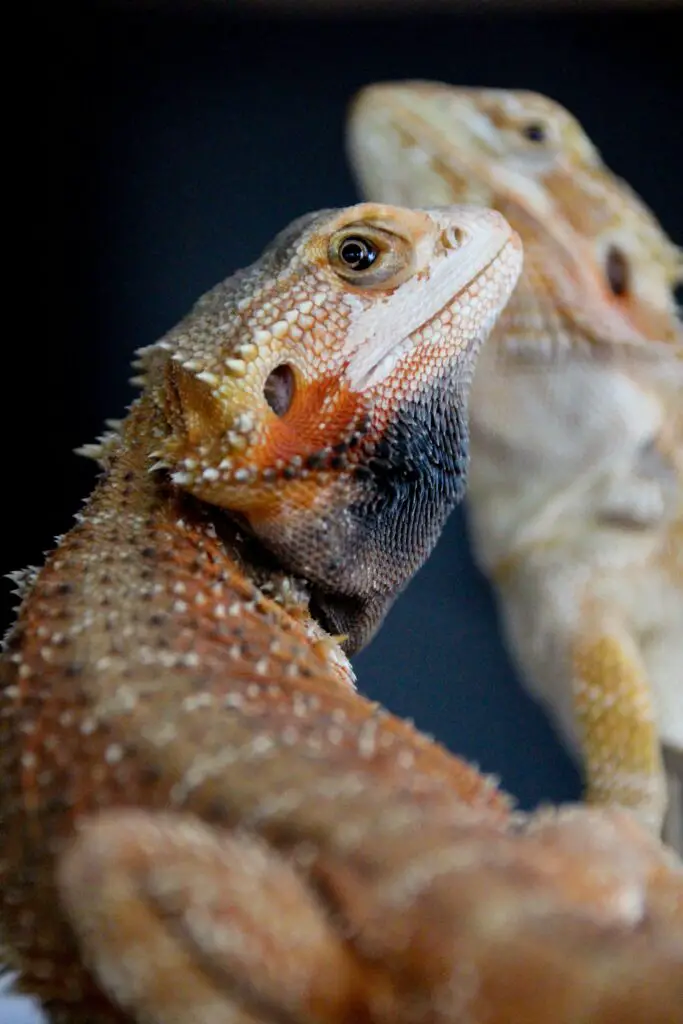75 gallon tank bearded dragon
75 gallon tank bearded dragon: Bearded dragons, known scientifically as Pogona vitticeps, have gained immense popularity in recent years as reptile pets. These captivating creatures hail from the arid regions of Australia, and their unique appearance and docile nature make them a favorite among reptile enthusiasts. With their majestic fringed necks, spiky bodies, and curious personalities, bearded dragons have become increasingly sought after as pets for both experienced herpetologists and first-time reptile owners alike.
Brief Overview of Bearded Dragons as Popular Reptile Pets
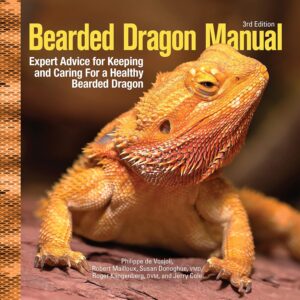 Bearded dragons have unquestionably earned their reputation as one of the most popular reptiles to keep as pets. One of the reasons for their popularity is their calm temperament.
Bearded dragons have unquestionably earned their reputation as one of the most popular reptiles to keep as pets. One of the reasons for their popularity is their calm temperament.
Unlike some other lizard species that are prone to aggression or skittishness, bearded dragons are generally quite docile. They exhibit a level of trust towards humans and show little aversion to being handled when raised in a nurturing environment.
Another appealing aspect of owning a bearded dragon is their manageable size. While they can grow up to 24 inches in length (including the tail), they typically reach an adult size of around 18-22 inches.
This makes them suitable for both small apartments and spacious homes. Additionally, bearded dragons do not require extensive exercise or large enclosures like some other reptiles may demand.
Introduction to the 75-Gallon Tank as an Ideal Habitat for a Bearded Dragon
Providing an appropriate habitat is crucial for ensuring the health and well-being of any pet, including bearded dragons. The 75-gallon tank offers an ideal living space that adequately caters to the needs of these fascinating creatures throughout various stages of their lives.
A 75-gallon tank provides ample room for your bearded dragon to explore its surroundings while allowing you enough space to create an enriching environment. These tanks typically measure 48 inches in length, 18 inches in width, and 20 inches in height.
This size allows for the inclusion of essential elements such as basking spots, hiding areas, and climbing structures. Moreover, a larger tank like the 75-gallon option ensures that your bearded dragon has sufficient space to move around comfortably, promoting healthy physical development.
It also reduces the risk of territorial behavior or stress caused by restricted movement. With proper setup and care, a 75-gallon tank can serve as a safe and stimulating home where your bearded dragon can thrive for many years to come.
Understanding Bearded Dragons
Description of bearded dragons as native to Australia
Bearded dragons, scientifically known as Pogona, are fascinating reptiles that hail from the arid regions of Australia. They have become increasingly popular as pets due to their unique appearance and manageable size.
These reptiles are named “bearded dragons” due to their ability to puff out the skin under their chin, resembling a beard. They belong to the Agamidae family, which includes around eight different species.
Overview of their physical characteristics, including size and color variations
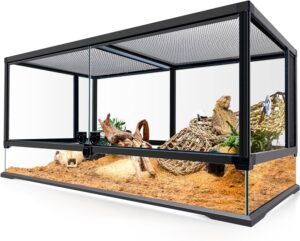 Bearded dragons showcase a variety of physical features that make them stand out among other reptiles. On average, these lizards can grow up to 18-24 inches in length from head to tail tip, with males generally being larger than females.
Bearded dragons showcase a variety of physical features that make them stand out among other reptiles. On average, these lizards can grow up to 18-24 inches in length from head to tail tip, with males generally being larger than females.
Their body is covered in rough scales that provide excellent protection against predators and harsh environmental conditions. One notable aspect of bearded dragons is their remarkable color variations.
In the wild, they display shades of brown and gray that help them blend into their natural surroundings. However, through selective breeding efforts by dedicated enthusiasts over the years, captive-bred bearded dragons now come in an array of vibrant colors such as orange, red, yellow, and even blue or purple hues.
Explanation of their unique behaviors and temperament
Bearded dragons exhibit a range of captivating behaviors that make them endearing pets for reptile enthusiasts. One particular behavior is head bobbing—a distinctive movement where they rhythmically nod or tilt their heads up and down. This behavior can serve various purposes such as territorial display or courtship rituals.
Another intriguing behavior is “arm-waving,” which involves one or both forelimbs being raised in slow motions almost like waving goodbye. This gesture is often seen when bearded dragons feel threatened or want to establish their dominance.
In terms of temperament, bearded dragons are generally known for their docile and friendly nature. With proper handling and socialization from a young age, they can become quite comfortable being interacted with by their owners or even strangers.
However, it’s important to note that each lizard has its own personality, and some individuals may be more prone to aggression than others. Therefore, patience and understanding are key when building a relationship with these captivating reptiles.
The Importance of Proper Housing
When it comes to keeping a bearded dragon as a pet, providing proper housing is paramount to ensure their overall well-being. These fascinating reptiles require adequate space to move around, bask in the light, exercise, and exhibit natural behaviors.
A spacious habitat enables them to thrive both physically and mentally. By offering an environment that meets their needs, we can contribute to their long-term health and happiness.
Discussion on the Significance of Providing Adequate Space
Adequate space is crucial for bearded dragons due to their active nature and territorial tendencies. In the wild, they roam vast areas of arid Australian landscapes, soaking up sunlight and exploring various microhabitats. Captivity should aim to replicate these conditions as closely as possible.
By providing a spacious enclosure, we allow our scaly companions the freedom to move about comfortably. Furthermore, ample space within the habitat encourages natural behaviors such as climbing on branches or rocks, digging in the substrate, and even hunting for live prey during feeding time.
When confined in small enclosures with limited movement options, bearded dragons may become stressed or frustrated. This can lead to various behavioral problems like lethargy or aggression.
Explanation of Why a 75-Gallon Tank is Considered Optimal
Among various tank sizes available in the market for housing bearded dragons, a 75-gallon tank is often recommended for adult dragons due to its ideal dimensions and capacity. This size provides sufficient floor area for them to wander around comfortably while also allowing space for essential accessories like basking spots and hides.
A 75-gallon tank allows sufficient room for setting up different temperature zones within the enclosure so that your dragon has choices when it comes to maintaining its preferred body temperature throughout the day. It also permits the inclusion of multiple hides to create secure resting places, which is essential for bearded dragons as they seek shelter and solitude periodically.
Not only does a 75-gallon tank ensure that your bearded dragon has enough space to express its natural behaviors, but it also allows for better air circulation, heat distribution, and overall easier maintenance. With proper ventilation and the right setup, this tank size provides a comfortable and spacious home for your beloved bearded dragon.
Setting Up the 75-Gallon Tank
Selecting the Right Tank
When it comes to providing a suitable habitat for your bearded dragon, selecting the right tank is crucial. Considerations such as material, dimensions, and ventilation options play a significant role in ensuring your pet’s comfort and well-being. Opt for a tank made of glass or acrylic, as these materials offer excellent visibility and are easy to clean.
Glass tanks provide better insulation, while acrylic tanks are more lightweight and resistant to cracks or breakage. In terms of dimensions, a 75-gallon tank provides ample space for an adult bearded dragon to roam and explore comfortably.
Ensure that the tank is at least 48 inches in length, as this promotes sufficient movement and accommodates essential accessories such as basking spots and climbing structures. Additionally, consider the height of the tank; a taller enclosure allows for vertical exploration opportunities that mimic their natural habitat.
Choosing Appropriate Substrate
The substrate you choose for the tank floor plays an important role in maintaining cleanliness and preventing potential health issues for your bearded dragon. There are various options available, but reptile carpet or ceramic tiles are highly recommended due to their hygienic properties.
Reptile carpet provides a soft surface that does not pose any risk of impaction if accidentally ingested by your pet during feeding time. It can be easily removed and washed regularly to ensure cleanliness within the enclosure.
On the other hand, ceramic tiles offer excellent durability and provide a stable surface for your bearded dragon to walk on comfortably. Avoid using loose substrates like sand or wood chips as they can pose ingestion risks which may lead to intestinal blockages or respiratory issues if particles become airborne.
Installation Guide: Essential Components
Proper heating elements and UVB lighting fixtures are essential components that need careful consideration during the setup of a 75-gallon tank for a bearded dragon. Ensuring optimal temperature and providing adequate UVB radiation are crucial for their health and well-being.
For heating, consider installing basking lights and ceramic heat emitters. Basking lights simulate the warmth of the sun and provide a necessary hotspot where your bearded dragon can regulate its body temperature.
Ceramic heat emitters, on the other hand, emit infrared heat without any light, which helps maintain the required ambient temperature within the tank. Alongside heating elements, UVB lighting fixtures are crucial to meet your bearded dragon’s need for vitamin D3 synthesis.
These fixtures emit UVB rays that aid in calcium absorption, essential for bone health and preventing metabolic bone disease. When installing these fixtures, ensure they are securely mounted within the tank while also considering positioning to create appropriate heat gradients and levels of exposure to UVB radiation throughout the enclosure.
By carefully selecting the right tank, substrate, and essential components like heating elements and UVB lighting fixtures, you are taking important steps in creating an ideal habitat for your bearded dragon. Providing an environment that accommodates their natural needs will contribute significantly to their overall well-being and happiness.
Creating a Comfortable Environment
Detailed explanation on temperature requirements, including basking spots and cool zones within the tank
Creating the right temperature gradient within a bearded dragon’s tank is crucial for their overall health and well-being. Bearded dragons are ectothermic creatures, meaning they rely on external heat sources to regulate their body temperature. In order to provide them with a comfortable environment, it is essential to establish both basking spots and cool zones within the tank.
The basking spot should be located at one end of the tank and should reach a temperature between 95°F to 105°F (35°C – 40°C). This area mimics the natural habitat of bearded dragons where they can absorb heat and properly digest their food.
The cool zone, on the other hand, should be situated at the opposite end of the tank and maintain a temperature range of around 75°F to 85°F (24°C – 29°C). This cooler area allows your pet to escape from excessive heat and regulate their body temperature as needed.
Description of suitable thermometers to monitor temperature accurately
To ensure that your bearded dragon’s tank maintains appropriate temperatures, it is essential to have reliable thermometers in place. Two types are particularly useful: digital probe thermometers and infrared thermometers.
Digital probe thermometers consist of a probe that can be placed directly in various areas of the tank while displaying accurate readings on a digital screen outside the enclosure. These are ideal for monitoring both basking spot temperatures as well as cool zone temperatures simultaneously.
Infrared thermometers, also known as temp guns or non-contact thermometers, allow you to measure surface temperatures without physical contact with objects inside the tank. This type of thermometer is particularly helpful in determining surface temperatures within different areas if you want quick readings without disturbing your pet’s environment.
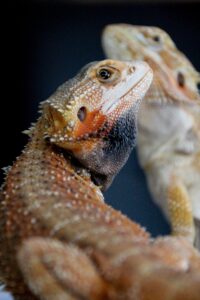
Tips on using thermostats to regulate heat sources effectively
Thermostats are essential tools for maintaining stable and safe temperatures within your bearded dragon’s tank. They help regulate heat sources such as basking lights and ceramic heat emitters, ensuring they do not exceed or fall below the desired temperature range. When setting up a thermostat, it is important to place the temperature probe in the appropriate location.
For instance, if you are using a basking light as the primary heat source, position the probe close to the basking spot so that it accurately measures the temperature your bearded dragon experiences while basking. Additionally, always make sure to calibrate and test your thermostat before relying on its accuracy.
You can use separate thermometers in combination with the thermostat to cross-reference and ensure consistent readings. Regularly check and maintain your thermostats to ensure proper functionality, providing a safe and stable environment for your bearded dragon at all times.
Furnishing the Tank
Suggestions for providing various types of hides (rock caves, logs) to create secure hiding spots
Creating a secure and comfortable environment for your bearded dragon is essential for their overall well-being. One way to achieve this is by providing various types of hides within the tank.
Bearded dragons are naturally inclined to seek shelter and hide when they feel stressed or threatened. To cater to this instinct, it is recommended to incorporate rock caves or logs as hiding spots in their enclosure.
These structures not only offer a sense of security but also mimic the natural habitat of bearded dragons, making them feel more at ease. When choosing rock caves or logs, opt for ones that are appropriately sized for your dragon’s comfort.
Ensure that they have smooth edges and surfaces to prevent any injuries during exploration. Additionally, consider placing these hiding spots strategically in different areas of the tank so that your pet can easily retreat into them regardless of where they are within their enclosure.
Recommendations for adding climbing structures like branches or hammocks to promote exercise and mental stimulation
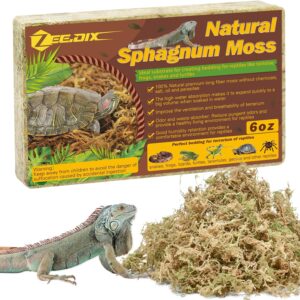 Bearded dragons are active creatures that enjoy climbing and exploring their surroundings. Providing them with climbing structures not only encourages exercise but also enhances their mental stimulation.
Bearded dragons are active creatures that enjoy climbing and exploring their surroundings. Providing them with climbing structures not only encourages exercise but also enhances their mental stimulation.
Incorporating branches or hammocks within the tank creates opportunities for your dragon to climb, bask, and observe its surroundings from different vantage points. When selecting branches, ensure they are sturdy enough to support your dragon’s weight without breaking or posing any risk of injury.
Avoid using branches from toxic plants or those treated with pesticides as they can be harmful if ingested accidentally. Hammocks are another fantastic addition that provides both comfort and stimulation for your bearded dragon.
These suspended platforms allow them to lounge while observing their environment from a unique perspective. Choose durable hammocks made from reptile-safe materials that can withstand regular use.
Diet and Feeding Guidelines
Overview of a balanced diet consisting primarily of insects
A well-balanced diet is crucial for the health and vitality of your bearded dragon. In the wild, bearded dragons are omnivorous, consuming a combination of insects, greens, and fruits. However, it is important to note that as they age, their dietary requirements shift towards more insect-based nutrition.
To provide a balanced diet for your bearded dragon, ensure that approximately 80% of their food consists of appropriately sized insects such as crickets, mealworms, dubia roaches, and silkworms. These insects provide essential proteins and fats necessary for growth and maintenance.
It is advisable to offer a variety of insect species to ensure a diverse nutrient profile. In addition to insects, around 20% of your dragon’s diet should consist of leafy greens and vegetables.
Suitable options include collard greens, dandelion greens, kale, squash, bell peppers, and carrots. Remember to finely chop or shred the veggies into manageable pieces for easier consumption.
To sum up 75 gallon tank bearded dragon
Creating an enriching habitat for your beloved bearded dragon not only ensures their physical well-being but also provides them with mental stimulation. By incorporating hiding spots like rock caves or logs within the tank along with climbing structures such as branches or hammocks, you create an environment that closely mimics their natural habitat while promoting exercise and exploration.
Furthermore, providing a well-balanced diet consisting primarily of insects supplemented with leafy greens ensures that your bearded dragon receives the necessary nutrients for optimal growth and health. By furnishing their tank appropriately and taking care of their dietary needs diligently, you are laying the foundation for a happy and thriving companion who will bring joy to your life for years to come.
Further Reading:
- Carolina Custom Cages Terrarium Review
- 8 Best Basking Rocks for Beardie: What Is the Best Choice?
- 10 Best Thermometers for Beardie: How to Choose the Best One?
- 5 Best Beardie Lighting Setups for Beardie Lovers
- 9 Best Heat Lamps for Beardie: Natural Habitat Provided

